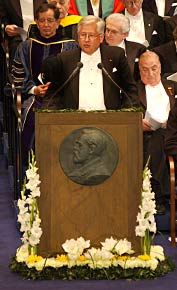Award ceremony speech
Presentation Speech by Professor Per Ahlberg of the Royal Swedish Academy of Sciences, December 10, 2001.
Translation of the Swedish text.

Copyright © Nobel Media AB 2001
Photo: Hans Mehlin
Your Majesties, Your Royal Highnesses, Honoured Nobel Laureates, Ladies and Gentlemen,
Science is exciting. At least I think so, along with everyone else here beside and behind me on this stage. As humans, we possess curiosity. With the aid of science we can discover answers – and surprises. That is exciting. But when I am going to explain something to a person who does not work with science, I hear: That may be interesting, but what is it good for? In the case of this year’s Nobel Prize in Chemistry, I have no such problems. That is because it is very easy to answer the question. Many of today’s drugs are based on our knowledge of fields where this year’s Laureates have made important discoveries; they are based on mirror images of molecules.
This year’s Nobel Prize in Chemistry concerns molecules that occur in two forms that are mirror images of each other. Such molecules are called “chiral” after the Greek work cheir meaning hand. Our hands are chiral – our right hand is a mirror image of our left hand – like most of life’s molecules. In our cells we find only one of these forms. This is true, for example, of enzymes, antibodies, hormones and DNA.
Thus the enzymes in our cells are chiral, as are other receptors that play an imporant part in cell machinery. This means that they prefer to bind to one of the mirror image forms. The two forms of a chiral molecule often have totally different effects on cells. For example, the receptors in our nose are sensitive to mirror symmetry. One form of the substances limonene smells like lemons, while its mirror image smells like oranges. Most drugs consist of chiral molecules, and often only one of the mirror image forms is of interest. The other form may even be harmful. This was the case, for example with the drug thalidomide, which was given in the 1960s to pregnant women. One mirror image form helped against nausea, while the other one – as it was discovered too late – could cause fetal damage.
It is obviously imporant to be able to produce each of the forms, as pure as possible. When producing compounds in the laboratory, ordinarily the result is equal quantities of both mirror image forms. This year’s Nobel Laureates in Chemistry have developed chiral catalysts in order to produce only one of the forms. A catalyst is a substance that speeds up reactions without itself being consumed.
In 1968 William Knowles was the first who was able to demonstrate that chirally catalyzed hydrogenation is feasible. It was a timely discovery that immediately inspired many researchers. Knowles quickly applied his own basic research and that of others to create an industrial synthesis of the drug L-DOPA, which is used in the treatment of Parkinson’s disease. Millions of patients have gained relief by using this medicine, including my own father, who suffered severely from this disease.
The man who lead the further development resulting in today’s more selective and general chiral hydrogenation catalysts was Ryoji Noyori. A single one of his catalyst molecules can yield millions of product molecules. His methods have gained very large practical importance, especially in industrial production of various antibiotics, for example. An important and, today, unfortunately highly newsworthy application.
Barry Sharpless has developed chiral catalysts for another important type of reactions – oxidations. His chirally catalyzed epoxidation and dihydroxylation reactions have given us new possibilities for also building complex molecules. They have gained very broad use, especially in industry, for example in producing medicines against ulcers and high blood pressure, two of our most serious health problems.
I have focused especially on the industrial role of the Laureates’ discoveries, but they also constitute extremely important tools in academic research, thereby contributing to more rapid advances in research – not only in chemistry but also in materials science, biology and medicine.
Alfred Nobel himself focused on the utilitarian aspect of science when he wrote in his will that the prize should be awarded to those who “shall have conferred the greatest benefit on mankind.” Thus this year’s Nobel Prize in Chemistry not only makes it easy to answer what science is good for, but is also a prize entirely in the spirit of Alfred Nobel.
Dear Dr. Knowles, Dr. Noyori and Dr. Sharpless,
I have briefly described your discoveries and improvements. The beneficial consequences of our achievements to mankind are already plentiful and will certainly be amplified by the work of your numerous followers in the field of chiral catalysis.
On behalf of The Royal Swedish Academy of Sciences, I wish to convey our warmest congratulations and ask you to step forward to receive the Nobel Prize from the hands of His Majesty the King.
Nobel Prizes and laureates
Six prizes were awarded for achievements that have conferred the greatest benefit to humankind. The 14 laureates' work and discoveries range from quantum tunnelling to promoting democratic rights.
See them all presented here.
